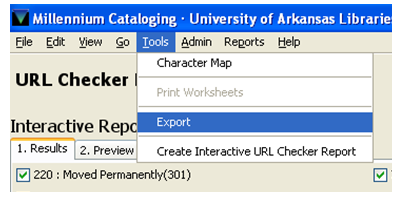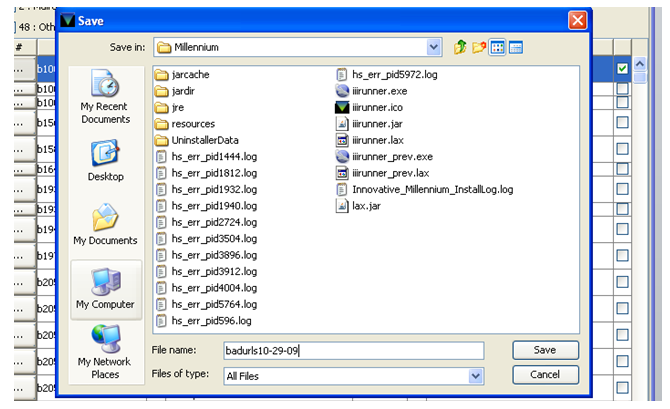1. CREATING A NEW LIST
In the Cataloging Module, select “Create Lists”. Create a list with the parameters you wish to select. To run the checker against Open Access Journals, create a list of those.
Next, go to the “URL Checker”. To do this, find the “Go” . Find the "Go" from the top menu, and open the URL checker

Select the “Create” icon from the top menu:

Once the window appears, select “Specify another Range” and choose “Review” from the drop down menu on the far left. Select your list from the menu on the right:

Select “OK”. It will run the checker against the list you have selected.
2. ACCESSING MOST CURRENT LIST
The URL checker is only able to run one list at a time. Other librarians are able to run the list or may have to run it against other parameters, besides the Open Access List.
The Open Access List, when run, checks all of the 856 URLs and records errors into different categories. For a list of error Categories and their meanings, please see Appendix A.
Once you have opened the URL Checker, choose “Interactive report” from the top right menu.
This will take you to the most current list of broken URLs. To limit the list to specified errors, like 404 errors, uncheck all over the other parameters. The list will then be filtered by your selections only.
NOTE: Only one person at a time is allowed access to the Interactive List.
The list is divided into 7 columns.
3. NAVIGATING AND MANIPULATING THE LIST
Viewing the Record: It is possible to view and edit bibliographic records directly from this list by selecting the “Edit” icon from the top right.
NOTE: The new window has a ‘locked’ size which you cannot stretch, enlarge, or shrink.
Opening the URL: By selecting the button under a “GO” column, you can launch a browser window directed to the URL to the right of the Go button.
Filtering the List: To filter out certain error types from the list, unselect the boxes at the Results tab. Bib. records with URLS with those types of errors will not appear on the list.
4. EXPORTING THE LIST INTO EXCEL
Exporting the list into an Excel file can be an easy way to free the list in the Cataloging module for other users, delegate the finding of correct open access urls for users, dividing the task of correcting large lists of broken URLs, and easily identify URLs you have already corrected.


Finding New URLS:
The process for finding the electronic version of the resource will vary depending on personal experience & preference, advice. A list of tips and helpful advice can be found in Appendix B: Guide Finding Open Access Titles on the Web.
When you find a possible replacement URL, keep these guidelines in mind:
Replacing URLs: The Batch Process Method
Once you have pasted a new URL in the list, you can use the system to automatically replace the old one in the bibliographic record. This is especially useful if you are correcting multiple records at once. Once you paste the new URL in the new URL column, check the selection box next to it, and select the “Preview Tab”. The Preview tab shows all of the records you have selected for a correction, and includes the old URL and new URL. Selecting the “Process” button, all new URLs will replace the old in the 856’s of the selected titles automatically.
NOTE: This process will not remove the title(s) from the interactive list. These titles will only go away when the list is re-run and the URLs no longer bounce back error messages.
Manual Corrections
Those who have the proper authorizations and training can also manually replace the URL into the bibliographic record. This is helpful to correct single URLs and update the holdings, if they have also changed. Just select “Edit” from the list view and edit the URL and holdings, if applicable. Only those with the proper authorizations and training should be directly editing the bibliographic records.
Problems
STATUS CODES
The following is a list of codes returned for problem URLS, in order of urgency.
404- Not Found
Meaning: The URL is not working. The page has moved or no longer exists.
Action: The URL needs to be researched to determine if the resource still exists. The record can then be updated or deleted.
-5—Host Unreachable
Meaning: The URL is not working. The page has moved or no longer exists.
Action: The URL needs to be researched to determine if the resource still exists. The record can then be updated or deleted.
301—Moved Permanently
Meaning: The website has redirected the browser to a new URL.
Action: The record should be updated to the new URL.
403—Forbidden
Meaning: The server refused the connection. Our URL may lack the closing element (index.html, default.asp) that is required for access.
Action: The URL should be researched and updated.
-1—Connection Refused
Meaning: The server refused the connection. Our URL may lack the closing element (index.html, default.asp) that is required for access.
Action: The URL should be researched and updated.
505—HTML Version Not Supported
Meaning: The server does not support, or refuses to support, the HTTP protocol version that was used in the request message. This may mean that we are asking for asp pages, and they only have php, for example.
Action: The URL should be researched and corrected.
500—Internal Server Error
Meaning: The server encountered an unexpected condition which prevented it from fulfilling the request. Things could be broken on their end. Could be temporary.
Action: This should be investigated in case our records need to be updated or the vendor contacted.
502—Bad Gateway
Meaning: The server, while acting as a gateway or proxy, received an invalid response from the upstream server it accessed in attempting to fulfill the request. Usually this is our proxy server having troubles talking to the remote server and a temporary issue.
Action: These should only be checked if other problems have already been addressed.
503—Service Unavailable
Meaning: The server is currently unable to handle the request due to a temporary overloading or maintenance of the server. The implication is that this is a temporary condition which will be alleviated after some delay.
Action: The record should be checked to determine if the service is back online or if there is a better URL to use.
-4—Connection Timeout
Meaning: The server did not respond in a reasonable amount of time. This could be because our network was slow.
Action: Test URLS to see if it is still correct.
302—Moved Temporarily
Meaning: The requested resource resides temporarily under a different URL.
Action: These should only be checked if other problems have already been addressed.
-2 3—No URL
Meaning: The III system has a problem with the URL, which may or may not be valid. Either the site has moved more than once or the system was unable to connect.
Action: These should only be checked if other problems have already been addressed.
TIPS FOR FINDING CORRECT URLS
1. Check the domain URL by stripping away all elements up to the .org, .com, or .edu. For example, for a broken link like this:
http://www.awesomejournal.edu/publications/feb02.pdf
try this:
http://www.awesomejournal.edu
Hopefully, you will get back to a main homepage and can then find the issue or title in another page off the same site.
2. Look in OCLC. Sometimes the OCLC record can have an updated URL to the resource.
3. Identify areas of a homepage where publications might exist. For journals and newsletters, try looking for the word “publications”, “press”, or “what’s new”. For annual reports, try looking in the “About us” or “Investor relations” section.
4. Use the “Search” boxes of the main sites to find a publication.
5. Try a Google search on the author or title. Be sure to put your terms in quotation marks. For example:
“Ouachita Society of American Foresters” not Ouachita Society of American Foresters.
PLEASE NOTE: When using Google, it is important to find an equivalent type of url so the url from a free resource is not replaced with a paid type of resource. This can be difficult to assess from campus because the proxy recognizes the IP and so the proxy doesn't display in the browser on the url line. If in doubt work with your supervisor.
6. Try the Internet WayBack Machine: http://www.archive.org/web/web.php . This can be useful at examining the sites before they became invalid to see if there was ever a redirect link posted. Also useful for harvesting Arkansas serials which are no longer available.